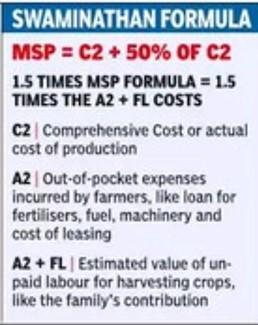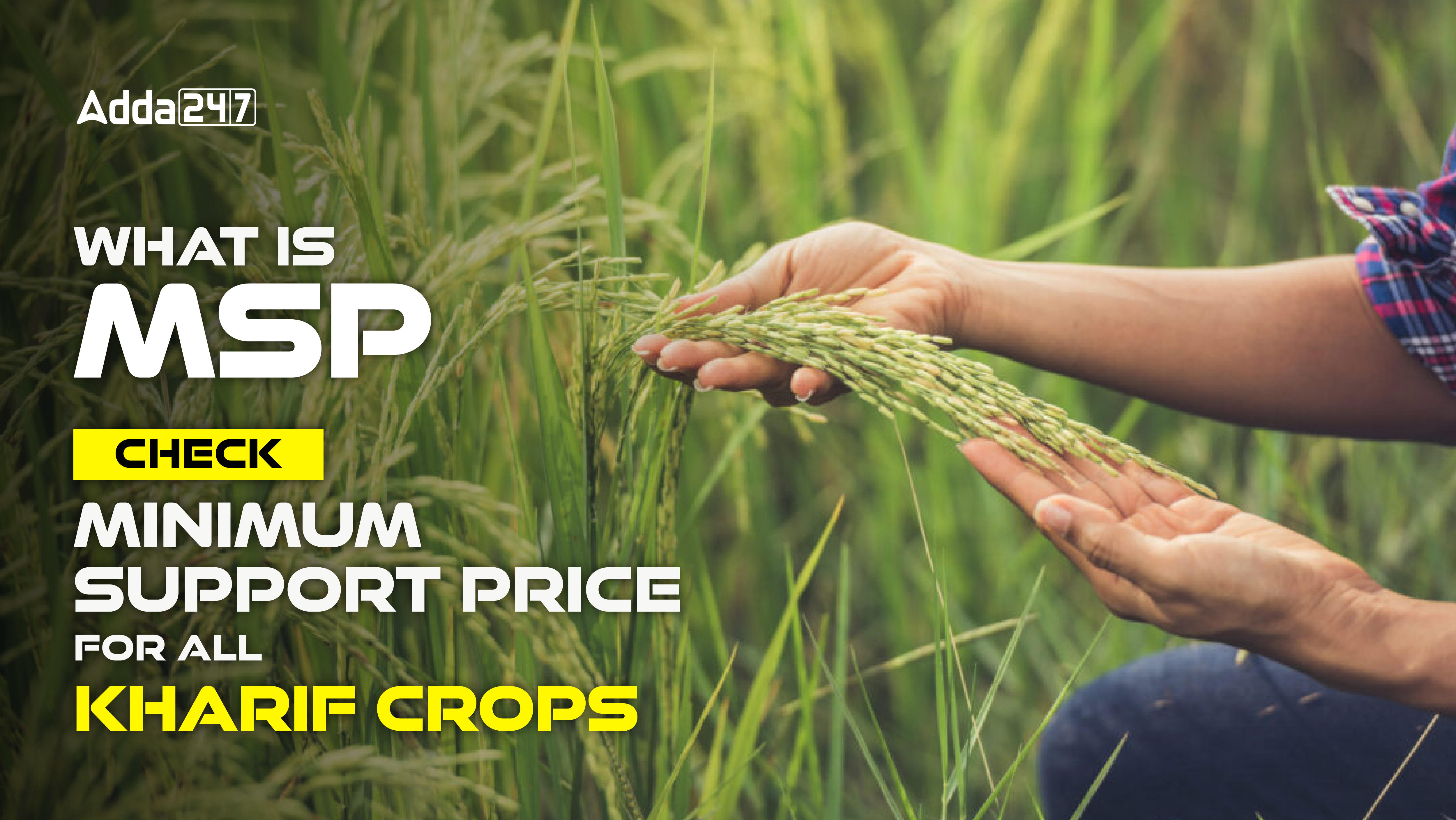Table of Contents
Minimum Support Price (MSP) is used by the government of India as a type of market intervention to protect farmers from a sudden decline in agricultural prices. At the start of the planting season, the Indian government announces minimum support prices for specific crops based on the recommendations of the Commission for Agricultural Costs and Prices (CACP). The MSP is a price set by the Indian government to shield farmers who are the producers from unjustified price drops in years of exceptional output.
MSP from a historical perspective
The government’s price support policy aims to protect farmers from a sudden and severe decline in farm prices. To create a floor below which market prices cannot go, the minimum guaranteed prices are set. The government published two types of administered prices up until the mid-1970s:
- Minimum Support Prices
- Procurement Prices
The government set the MSPs, which worked as floor prices and provided producers with a long-term guarantee that the prices of their commodities would not drop below the set level—even in the event of a bumper crop—when making investment decisions.
The prices at which kharif and rabi cereals were to be domestically purchased by government organizations (such as the FCI) and released through PDS were known as procurement prices. Not long after harvest started, it was declared. Procurement prices were typically greater than the MSP and lower than the open market price.
In the case of paddy, this policy of announcing two official prices persisted with some modification until 1973–1974. Regarding wheat, it was put on hold in 1969 and then brought back for a single year in 1974–1975. The current method, in which only one set of pricing is released for paddy (and other Kharif crops) and wheat being procured for buffer stock operations, was developed in 1975–1976 due to the overwhelming demand for raising the MSP.
Calculating the Minimum Support Price
The Commission considers the following variables in addition to a thorough analysis of the full economic structure of a certain item or group of commodities when producing recommendations about the level of minimum support prices and other non-price measures:
- Production costs
- Price adjustments for inputs
- Parity in input-output costs
- Changes in market values
- Supply and demand
- Price parity between crops
- Impact on the cost structure of the industry
- Impact on living expenses
- Impact on the overall level of prices
- Global pricing environment
- The balance between the prices paid and the farmers’ receipts
- Effects on issue prices and how they relate to subsidies

Crops covered by MSP
The government releases the fair and remunerative price (FRP) for sugarcane as well as the minimum support prices (MSPs) for the 22 required crops. Fourteen kharif crops, six rabi crops, and two additional commercial crops are the required crops. Furthermore, the MSPs of copra and rapeseed/mustard, respectively, are the foundation for fixing the MSPs of toria and dehusked coconut. The following is a list of crops.
- Cereals: ragi, bajra, jowar, wheat, barley, and paddy.
- Pulses: urad, lentil, moong, gram, and arhar/tur
- Oilseeds: sesamum, nigerseed, toria, groundnut, rapeseed/mustard, sunflower seed, and soybean.
- Raw sugarcane (fair and compensatory price)
- Raw cotton
- Raw jute
- Copra
- Dehusked coconut
- Tobacco treated with Virginia flu (VFC)
MSP for Kharif Crops for Marketing Season 2024-25
Under the direction of Prime Minister Shri Narendra Modi, the Union Cabinet decided today to raise the Minimum Support Prices (MSP) for all required Kharif Crops for the 2024–2025 marketing season.
The MSP for Kharif crops has been raised by the government for the 2024–2025 marketing season to guarantee growers fair pricing for their produce. It is suggested that oilseeds and pulses, specifically nigerseed (Rs.983/- per quintal), sesamum (Rs.632/- per quintal), and tur/arhar (Rs.550/- per quintal), receive the largest absolute gain in MSP compared to the previous year.
| MSP for Kharif Crops (2024-25) | ||||||
|---|---|---|---|---|---|---|
| Category | Crop | MSP (Rs. per quintal) | Cost* KMS 2024-25 (Rs. per quintal) | Margin over cost (%) | MSP 2023-24 (Rs. per quintal) | MSP Increase in 2024-25 over 2023-24 (Rs. per quintal) |
| Cereals | Paddy (Common) | 2300 | 1533 | 50 | 2183 | 117 |
| Paddy (Grade A) | 2320 | – | – | 2203 | 117 | |
| Jowar (Hybrid) | 3371 | 2247 | 50 | 3180 | 191 | |
| Jowar (Maldandi) | 3421 | – | – | 3225 | 196 | |
| Bajra | 2625 | 1485 | 77 | 2500 | 125 | |
| Ragi | 4290 | 2860 | 50 | 3846 | 444 | |
| Maize | 2225 | 1447 | 54 | 2090 | 135 | |
| Pulses | Tur (Arhar) | 7550 | 4761 | 59 | 7000 | 550 |
| Moong | 8682 | 5788 | 50 | 8558 | 124 | |
| Urad | 7400 | 4883 | 52 | 6950 | 450 | |
| Oilseeds | Groundnut | 6783 | 4522 | 50 | 6377 | 406 |
| Sunflower Seed | 7280 | 4853 | 50 | 6760 | 520 | |
| Soybean (Yellow) | 4892 | 3261 | 50 | 4600 | 292 | |
| Sesamum | 9267 | 6178 | 50 | 8635 | 632 | |
| Nigerseed | 8717 | 5811 | 50 | 7734 | 983 | |
| Commercial Crops | Cotton (Medium Staple) | 7121 | 4747 | 50 | 6620 | 501 |
| Cotton (Long Staple) | 7521 | – | – | 7020 | 501 | |
- MSP: Minimum Support Price per quintal for the Marketing Season 2024-25.
- Cost* KMS 2024-25: Cost of production or cost used for calculating MSP for the same season.
- Margin over cost (%): Percentage margin over the cost of production.
- MSP 2023-24: MSP for the previous Marketing Season 2023-24.
- MSP Increase in 2024-25 over 2023-24: Increase in MSP for the current season compared to the previous season.
Need for MSP
Farmers have been suffering from falling commodity prices since 2014 as a result of the twin droughts of 2014 and 2015. Demonetisation and the introduction of the Goods and Services Tax (GST) caused severe damage to the rural economy, particularly to the non-farm sector and agriculture.
For most farmers, the situation is still risky due to the epidemic and the subsequent slump in the economy after 2016–17. The suffering has only been increased by rising input costs for fertilizer, energy, and diesel.
It makes sure farmers get paid fairly for their produce, which lessens poverty and hardship on farms. This is especially important in states where the primary source of income is agriculture.
The Way Ahead
The list of crops eligible for MSP support might be gradually expanded by the government to promote crop diversity and lessen the dominance of rice and wheat. This will provide farmers with additional options and encourage the production of crops that meet consumer demand.
The government should concentrate on establishing MSPs for crops that are important to food security and those that have a proven influence on farmer livelihoods, rather than offering MSPs for every crop in every location. This focused strategy can aid in the best possible resource allocation.
Enhance and update the procurement processes to guarantee farmers may obtain MSPs. This could entail extending the reach of procurement agencies, cutting out middlemen, and developing more effective procurement processes.




 MPPSC Food Safety Officer Notification 2...
MPPSC Food Safety Officer Notification 2...
 ASRB NET Agronomy Syllabus 2025, Check S...
ASRB NET Agronomy Syllabus 2025, Check S...
 RPSC Agriculture Officer Answer Key 2025...
RPSC Agriculture Officer Answer Key 2025...


 Adda247 Job portal has complete information about all Sarkari Jobs and Naukri Alerts, its latest recruitment notifications, from all state and national level jobs and their updates.
Adda247 Job portal has complete information about all Sarkari Jobs and Naukri Alerts, its latest recruitment notifications, from all state and national level jobs and their updates.